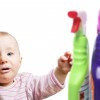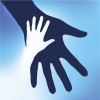 Children act fast, but so do poisons, including pesticides. Fortunately for most parents, their children are not harmed when the parents have a momentary lapse and aren’t supervising them for a short time. But how would parents respond if they suddenly turn around, and their toddler is holding a can of household aerosol insect killer? This 3-page fact sheet outlines some facts and precautionary measures regarding children and pesticides in the home environment, so parents have a better idea of how to keep harmful chemical products away from their children. Written by F.M. Fishel, and published by the UF Department of Agronomy, March 2013.
Children act fast, but so do poisons, including pesticides. Fortunately for most parents, their children are not harmed when the parents have a momentary lapse and aren’t supervising them for a short time. But how would parents respond if they suddenly turn around, and their toddler is holding a can of household aerosol insect killer? This 3-page fact sheet outlines some facts and precautionary measures regarding children and pesticides in the home environment, so parents have a better idea of how to keep harmful chemical products away from their children. Written by F.M. Fishel, and published by the UF Department of Agronomy, March 2013.
http://edis.ifas.ufl.edu/pi226
Tag: Child Safety
Save a Child: How to Identify and Report Child Abuse (FCS2119/HE855)
 People who work with children, parents, and the general public may at some point in their lives and careers have to report child abuse. It is important that you be able to recognize the symptoms of abuse and be able to contact the appropriate authorities. By reporting abuse, you may save a child’s life or prevent serious injury. This 4-page fact sheet discusses child abuse laws and procedures for reporting abuse. It also contains information about different types of abuse and how to identify abused or neglected children. Characteristics listed here are general and intended as guidelines. A child or family may exhibit many warning signs of abuse, though no abuse has occurred or ever will occur. Written by Andrew E. Toelle and Kate Fogarty, and published by the UF Department of Family Youth and Community Sciences, January 2013.
People who work with children, parents, and the general public may at some point in their lives and careers have to report child abuse. It is important that you be able to recognize the symptoms of abuse and be able to contact the appropriate authorities. By reporting abuse, you may save a child’s life or prevent serious injury. This 4-page fact sheet discusses child abuse laws and procedures for reporting abuse. It also contains information about different types of abuse and how to identify abused or neglected children. Characteristics listed here are general and intended as guidelines. A child or family may exhibit many warning signs of abuse, though no abuse has occurred or ever will occur. Written by Andrew E. Toelle and Kate Fogarty, and published by the UF Department of Family Youth and Community Sciences, January 2013.
http://edis.ifas.ufl.edu/he855
Sun Protection for Your Children (FAR0084/FM412)
 “My children were all born during the summer months, and as we gradually spent more and more time outside, I wondered how best to protect them from the hot summer sun.” This 2-page Family Album Radio transcript was written by Suzanna Smith, and published by the UF Department of Family Youth and Community Sciences, July 2012.
“My children were all born during the summer months, and as we gradually spent more and more time outside, I wondered how best to protect them from the hot summer sun.” This 2-page Family Album Radio transcript was written by Suzanna Smith, and published by the UF Department of Family Youth and Community Sciences, July 2012.
http://edis.ifas.ufl.edu/fm412
Choosing an Infant Carrier and Car Seat (FAR0431/FM435)
 “When bringing your new baby home from the hospital or birthing center, one of the items you can’t leave without is an infant car seat.” This 2-page Family Album Radio transcript was written by Donna Davis, and published by the UF Department of Family Youth and Community Sciences, July 2012.
“When bringing your new baby home from the hospital or birthing center, one of the items you can’t leave without is an infant car seat.” This 2-page Family Album Radio transcript was written by Donna Davis, and published by the UF Department of Family Youth and Community Sciences, July 2012.
http://edis.ifas.ufl.edu/fm435
PI226 Children and Pesticides
PI226, a 3-page illustrated fact sheet by F.M. Fishel, outlines some facts and basic precautionary measures regarding children and pesticides in the home environment. Includes references. Published by the UF Department of Agronomy, March 2010.
http://edis.ifas.ufl.edu/pi226
FAR0100/FM303 Missing Children
FAR-0100, a 2-page transcript of the Family Album Radio Program broadcast by Donna Davis, presents data from a report from the Department of Justice about the number of incidences of missing, abducted, runaway and thrownaway children to help parents put the risk of abduction into perspective. Includes references. Published by the UF Department of Family Youth and Community Sciences, March 2009.
http://edis.ifas.ufl.edu/FM303
FAR0304/FM300 Child Care Safety
FAR-0304, a 2-page transcript of the Family Album Radio Program broadcast by Suzanna Smith, describes research about the relative safety of child care settings. Includes references. Published by the UF Department of Family Youth and Community Sciences, March 2009.
http://edis.ifas.ufl.edu/FM300
FCS2119/HE855 Save a Child: Know How to Identify and Report Child Abuse
Revised! FCS2119, a 5-page fact sheet by Andrew E. Toelle and Kate Fogarty, discusses child abuse laws and procedures for reporting abuse. It also contains information about different types of abuse and how to identify abused or neglected children. Includes references. Published by the UF Department of Family Youth and Community Sciences, November 2008.
http://edis.ifas.ufl.edu/HE855